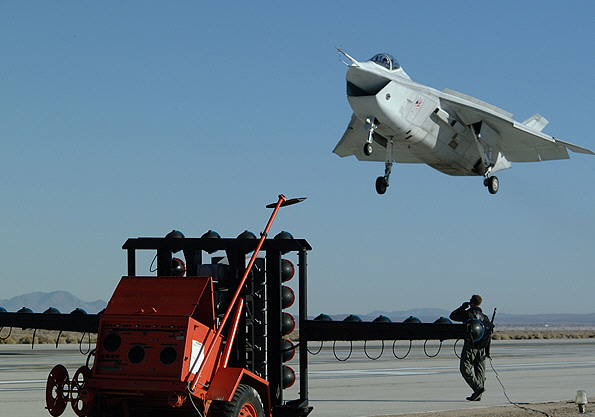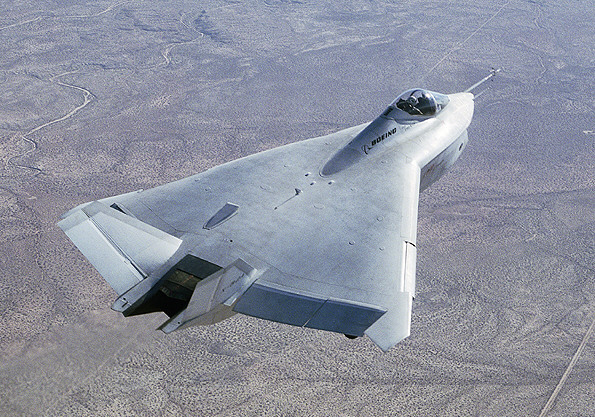
Posted on 05/02/2003 8:29:33 AM PDT by Excuse_My_Bellicosity
PATUXENT RIVER, Md. (NNS) -- Flight testing of the Vectoring, Extremely Short Takeoff and Landing, Control and Tailless Operation Research (VECTOR) X-31 ended April 29, following a week of successful demonstrations of the world's first fully automated, thrust vectored landings at up to 24 degrees angle of attack.
For three years, the VECTOR test team has been working to demonstrate the viability of thrust vectoring for extremely short takeoff and landing (ESTOL), using the unique X-31 as a test bed for the concept.
Marine Corps Maj. Cody Allee made the last flight of the thrust-vectored jet April 29, completing an automated ESTOL landing at 24 degrees angle of attack and 121 knots, a 31 percent reduction from the aircraft's normal landing speed of 175 knots.
The X-31 typically requires 8,000 feet to stop after a conventional landing, Allee said. Following his ESTOL touchdown, he needed just 1,700 feet to slow the X-31 down enough to turn around in the middle of the runway and taxi in a complete circle.
In contrast to a normal landing where the scenery is flying by as a blur in his periphery, Allee said, the world outside the canopy scrolled slowly past during the ESTOL approach at a pace that was "almost sedate."
The final landing was greeted with cheers in English and German from scores of test team members watching at runway's edge; since the beginning, VECTOR has been an international partnership between the Navy, Germany's Federal Office of Defense Technology and Procurement, European Aeronautic Defence and Space (EADS) Company, and Boeing Aerospace.
The program will now move into a data analysis and reporting stage, creating what will essentially be a how-to manual for thrust-vectored ESTOL and the technology demonstrated on the X-31.
Until German project test pilot Ruediger Knoepfel completed the first ESTOL landing here April 22, however, the technique was considered by many outside the program to be an unattainable ideal, said VECTOR Program Manager Jennifer Young.
"I don't know how many times we heard that this just couldn't be done," she said. "The cards were stacked against us for so long, and it was only the sheer determination and passion of everyone on the team that got us through."
Skepticism came from both sides of the ocean, according to EADS program manager Michael Jost.
"At the beginning of the program, the technology was looked on very critically, because a lot of (German) experts didn't believe it was possible," Jost said. "It put great pressure on the team to prove that it works and convince the non-believers."
On paper, descriptions of thrust-vectored ESTOL landings with the X-31 read a bit like science fiction. In order to land slower, the aircraft comes in at higher angles of attack - up to twice its typical 12 degrees - meaning its nose is pointed well above its direction of flight. At anything above 15 degrees angle of attack, the pilot loses sight of the runway.
"From the start of the approach, it is very obvious that the aircraft is sitting at a pretty extreme angle," Allee said. "You're still at one G, but you're leaning way back in the seat with the nose pointed way up at the sky."
More importantly, the tail of the aircraft is lower than the landing gear, requiring the X-31 to "derotate" and drop onto its wheels when the engine nozzle is just two feet above the runway.
Timing of that maneuver is critical. If the aircraft derotates early and drops too far, the landing gear could fail. If the aircraft derotates too late or too low, the tail could strike the runway with disastrous consequences. The solution was to automate the entire approach, requiring the pilot to fly into an invisible engagement box in the sky, then watch via a video camera in the belly of the plane as it flies itself to its remarkable touchdown. The system has to be accurate to within two centimeters.
"Everything has worked perfectly and far exceeded my expectations," Knoepfel said.
"We're getting real and very useful technology out of this program," Young said, "and it was a passionate belief in that fact that has kept this team going.
For related news, visit the NAVAIR - Naval Air Systems Command Navy NewsStand page at www.news.navy.mil/local/navair.


I expect to hear a lot about lost planes and lost pilots if this is mainstreamed.


The X-35 is a babe in comparison



Disclaimer: Opinions posted on Free Republic are those of the individual posters and do not necessarily represent the opinion of Free Republic or its management. All materials posted herein are protected by copyright law and the exemption for fair use of copyrighted works.